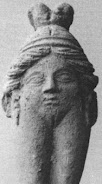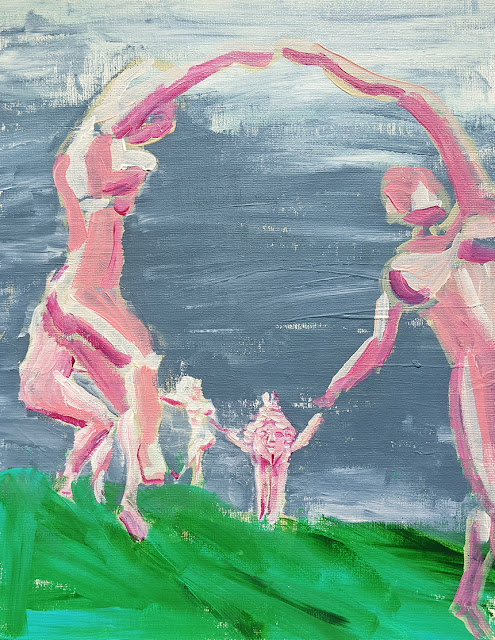Often compared to Sheela Na Gig, Baubo has a long and complex history. She was first mentioned by Christian writers around 200 CE. She appears in the story of Demeter, the Greek goddess of agriculture, who I happened to paint yesterday. Original painting of Demeter, prints, and merch available in shop or through RedBubble or Fine Art America.
Homer wrote that Iambe cheered Demeter by jesting, helping Demeter to rouse herself from depression after her daugher Persephone was taken. Because of Iambe, Demeter found the strength to fight to retrieve Persephone from the Underworld. Thanks, Iambe, you prevented eternal winter. As a result, the internet reports that iambic verse was named after Iambe.
Homer wrote that Iambe cheered Demeter by jesting, helping Demeter to rouse herself from depression after her daugher Persephone was taken. Because of Iambe, Demeter found the strength to fight to retrieve Persephone from the Underworld. Thanks, Iambe, you prevented eternal winter. As a result, the internet reports that iambic verse was named after Iambe.
The Christian writers, however, gave the role of cheering Demeter to a woman named Baubo, who, instead of using her wit and jokes, exposed her hilarious 'shameful parts'.
Later, Goethe included a lewd witch named Baubo, riding a sow to Walpurgis Night, in Faust. Subsequently, statuettes of women riding pigs and/or exposing their genitals were labeled Baubo.
Then, in 1898, a group of German archaeologists working in the 5th century BCE Demeter sanctuary at Priene unearthed a distinctive set of figurines. "The head of each of these female figurines is placed directly onto her legs, and lacking a torso, the chin and vagina [I think they mean vulva] merge into one another. The archaeologists identified this 'grotesque-obscene' aspect with Baubo, and the statuettes became known as Baubo figurines.
This disseration about Baubo was enlightening.
I wanted to paint Baubo, but I feel like she is somewhat misunderstood, and I wanted to understand her before attemping a painting. While the Christian and German men who wrote her history characterized her as an obscene witch, art historian Winifred Milius Lubell has another hypothesis for Baubo. From an article on bust.com "She thinks Baubo was another aspect of 'extremely ancient...agricultural rituals of fecundity,' in which chosen women 'squatted over the newly plowed fields' and allowed their menstrual blood to drip into the earth to increase its fertility. You might say that Baubo spoke truth to power, the servant's pussy flash reminding the grain goddess of her responsibility over the harvest and thus as a life-giving force to humanity. Without Baubo's timely reminder of the vulva's regenerative power, human civilization would have ended."
It has also been suggested that Baubo may have some relation to the Blemmyes, ancient rumored headless inhabitants of ancient Libya or the Nile system.
What we do know is that these figurines were found in a temple to Demeter, an agriculture goddess. So, I thought that perhaps she should be dancing in a field with her divine female friends. Are you into mysteries of the divine feminine? Would you like to own Baubo on a coffee mug or other merch? You can! On Redbubble and Fine Art America.




Comments
Post a Comment